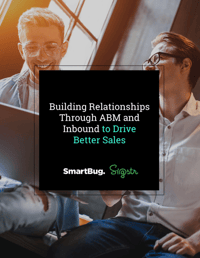
In a recent Forrester Research mission study conducted on behalf of RollWorks, marketers said it’s just as challenging to retain customers and grow existing accounts as it is to convert leads into net new opportunities. Seventy-five percent of those polled also noted that account-based marketing (ABM) had improved upsell and cross-sell opportunities via account-specific insights.
Account-based marketing is not only powerful in creating opportunities, but it’s also powerful when applied to your customer base, helping with:
- Reducing customer churn
- Growing upsell and cross-sell opportunities
- Addressing low customer engagement
Retaining customers should never be an afterthought, so how can you use ABM on your existing customer base to retain and grow it? Glad you asked, let’s dive in.
Applying Deal Closed-Lost Analysis Concepts to Your Customers
In deploying ABM to our customer base, SmartBug® has been successful by taking concepts from our new business marketing and modifying them for our existing customer base.
A short detour: SmartBug analyzes our closed-lost reasons.
Before talking about customer marketing, let’s take a quick look at an initiative that started with our new business marketing team before being applied to our customers.
Nobody likes moving deals to the closed-lost column, but these missed deals can also provide powerful learnings. At SmartBug, we consulted with our sales team to begin tracking “closed-lost reason.” This not only gave us better ideas to improve our sales process, but it also served as a leading indicator for future nurture campaign tracks.
Closed-lost reasons may vary for your business, but we’ve implemented some labels that are broadly applicable to other industries, including:
- Timing isn’t right: You might build three-, six-, or nine-month nurture campaigns that help you stay top of mind with prospects until the timing becomes right.
- Competitor: Consider nurturing these prospects with content that shows your expertise versus competitors.
- Contact went dark: Consider sharing your biggest wins and most impactful news with these prospects to recapture their attention.
Capturing closed-lost reasons gave us insights into why we were losing deals, which ultimately fed into a larger dashboard. You probably see where this is going when applied to customers ...
Enter SmartBug’s customer health dashboard.
Capturing closed-lost reasons with the help of our sales team got us thinking about what else we might track about our customers. Again, we started with categories that could reveal trends in the data.
SmartBug began analyzing our client churns. We broadly determined that churn is sometimes preventable and sometimes not. Furthermore, certain leading indicators emerged that sometimes predicted churn, and our goal was to reduce the preventable churn as much as possible.
From there we developed several types of campaigns to run in certain churn-risk scenarios. For example, we identified point-of-contact (POC) change as one trigger for churn and developed a “POC Change” nurture campaign to help new POCs understand our agency’s capabilities and strengths.
Four Go-To ABM Plays for Customer Retention and Growth
What indicators that your customers are moving away from your business could you begin to track?
1. Address low product usage.
Customer activity with your product leaves many data points you can use to assess customer health. Maybe they’re not using many features, or maybe they have a low product adoption score (if you track such a thing). Even if you don’t, common data points like product usage time or number of logins can help get you started in assessing your customer health.
This activity data can be combined with other data sources (like personas) to create a targeted, educational email series. You can highlight features or deploy in-app messaging (if that applies to you). Loop your customer success management (CSM) teams into your efforts; they can even hold office hours on product features to help increase that customer adoption score.
2. Respond to piqued competitor interest among your clients.
A spike in queries for competitor keywords or the services you provide might indicate that your customers are starting to look somewhere else. You can capture this information using ZoomInfo and other tools.
Alert roles responsible for client successes once you identify this competitive intelligence, because it’s all hands on deck to identify what your customer is looking for and how you can help them achieve that. Multi-channel campaigns, relationship building, and other efforts can help you reengage them.
On the SmartBug side, we know there’s only so much that technology can do. Human relationships become really pivotal to how your customer partnership evolves from there. In the same way we use intent data to identify new prospective accounts, we also use ZoomInfo to listen to our existing customers and monitor any competitor or dissatisfaction queries.
3. Message clients bingeing on certain categories of your content.
While the previous two plays were more reactionary, these next two encourage clients to continue the positive steps they’ve already started.
For cross-sell and expansion opportunities among existing accounts, start by categorizing your content across threads of commonality, whether that’s content type, stage of the buyer’s journey, or format. When you identify that a customer is accessing multiple pieces of content that you’ve grouped together, send them a product-oriented email nurture. Maybe even invite them to a lunch and learn about the product category they showed interest in.
This play gives you the opportunity to share new offerings your customer doesn’t use from you currently. A smaller, more intimate event can foster participation and help customers learn more about your company, offerings, and capabilities.
4. Identify your customer advisory board (CAB) for insights and engagement.
A customer advisory board (CAB) is typically made up of your best customers across your client base so you get the most diverse, yet valuable, feedback.
Not everyone starts their customer feedback program with a formalized CAB. Instead, you can start small with:
- Net promoter scores (NPS)
- Customer satisfaction (CSAT) reports
- Support tickets closed
- Email feedback from client-facing roles
- And so forth
You might also start with a voice of the customer (VOC) program. At the minimum, this VOC program could consist of someone in your department specifically designated to represent the VOC in your decision-making processes.
When the time came to create our SmartBug CAB, we followed a few important steps:
- We didn’t know how large our CAB should be—generally, we wanted more than five and less than fifty—so we worked with our client-facing teams to identify our critical accounts across the verticals we wanted to excel in.
- At our first CAB meeting, we took several steps to ensure everyone had the chance to provide meaningful feedback:
- We held the event virtually, but that didn’t mean it wasn’t enjoyable and interactive. We used breakout groups to create smaller, more intimate settings to foster conversation, and we also included a fun activity (fondue) to break up the “shop talk.”
- We emailed clients to let them know what the CAB consisted of, what other kinds of people they could expect to meet there, and what to expect of the event in general, all to ease any anxieties about joining.
- Before the event, we sent a survey about which pain points clients were experiencing. We then reviewed this data to group clients from different industries together by their pain points. These customers were paired together in our break-out groups.
The CAB helped position SmartBug as a partner that genuinely wants to help clients solve their business problems. We learned more about client pain points, and we set up ABM follow-up campaigns after the event.
As for the fondue, we scheduled ours in the middle of the CAB and would definitely recommend saving your activity until later in your agenda!
Using ABM to Keep and Grow Accounts: Q&A Session
Can SmartBug provide examples of the targeted ABM for the CAB play?
At SmartBug, our client services team created personalized videos to invite clients to join the CAB, providing details and what they could expect to gain from participating. Then during the event itself, we had a chef-led experience to break up the “shop talk.” We shared the feedback with the client service account owner and also sent follow-up campaigns based on pain points.
What tool does SmartBug use for the customer health dashboard?
Everything we use is either created in or integrated with HubSpot.
How can marketers implement retention programs with less-than-perfect existing data?
Don’t let the perfect be the enemy of the good! The data you do actually have might be a proxy for something else. For example, you might not have a product score, but can you supplement that with time-in-product instead? There may be other clever ways, such as Intercom, to gather data now until you can get a more permanent integration or solution.
Also, if there is one piece of the puzzle that you’re stuck on, (e.g., who at a client company represents which point of contact), then do a cleanup in advance to prep for your ABM program. Start with a smaller cleanup program to solve the piece today that you need solved today, so your future effort can be more successful.
Can you share some best practices for aligning customer success managers (CSMs) and sales when it comes to ABM?
Typically, ABM uses pods of sales reps and CSMs based around your go-to-market efforts across different segments: marketer, demand gen, content, CSM/AM, and sales manager.
Meet up regularly (e.g., biweekly) to see what is changing in the market. At RollWorks, we’ve found that these check-ins naturally facilitate alignment. You need to convey the value of this alignment to both teams and demonstrate how it informs their success.
Another large area for alignment is the initial handoff from sales to marketing. You can do something similar with customer-facing ABM.
Treat your customers as your “customer target accounts” to decide how you might message to them, and you have a pathway to more delight stage marketing:
- Send a welcome kit once they’re online.
- Develop a campaign before their renewal date.
- Align a campaign with their first business review.
Can you share a favorite customer campaign?
The lunch and learn is a classic, with smaller groups to learn more about your features. Smaller events always facilitate great conversation and also an increase in total contract value.
To watch the full webinar recording, visit RollWorks.

About the author
Charly Mostert was formerly an Inbound Marketing Strategist at SmartBug Media. With diverse in-house and agency experience, he loves researching and spreading the word on the newest inbound marketing best practices. Read more articles by Charly Mostert.


![[FREE EBOOK] Weave ABM Into Your Inbound Strategy](https://no-cache.hubspot.com/cta/default/142915/db8a46d5-388f-47e9-b0c7-d5083355741d.png)





